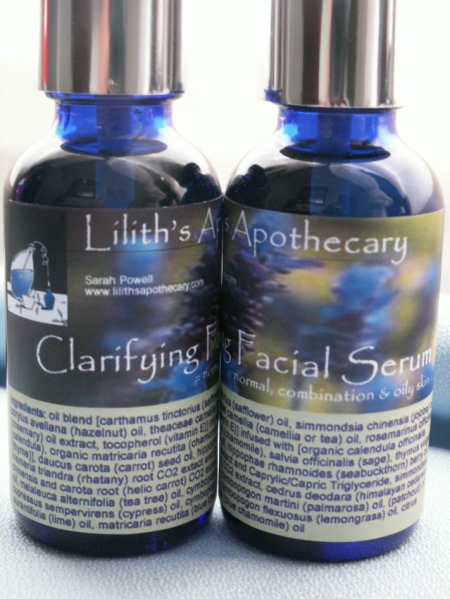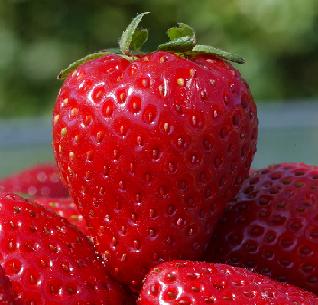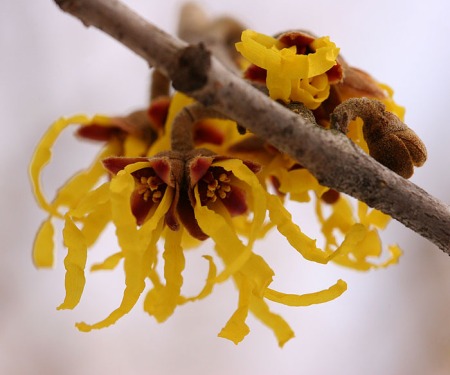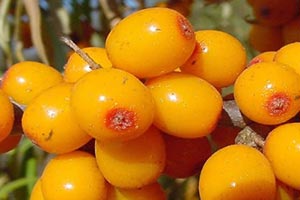 What a Treat! I just read a wonderful review of my Clarifying Serum on a product review site called Hot Ink. The reviewer has been using the serum for a year, and though she started with skin that was dryish in places, but also prone to oiliness, acne, and sensitivity, all of these issues have been resolved from using this serum as her primary moisturizer. I made a fresh batch just a week ago and can attest to how chock-full of goodness it is. I now infuse the oils with organic thyme (antiseptic), chamomile (anti-inflammatory), and calendula (healing) to further bolster the power of the oils. Yay! I love to hear success stories with what I believe to be a great product, and I really wanted to share this with all of you, my dear readers. (I know you likely thought I had dropped off the edge of the planet, but fear not, I haven’t, and trust me: I am getting back on board with devotion to my blog. Lots of news to update you on! And I will! Soon.) For now, read this awesome review. 🙂
What a Treat! I just read a wonderful review of my Clarifying Serum on a product review site called Hot Ink. The reviewer has been using the serum for a year, and though she started with skin that was dryish in places, but also prone to oiliness, acne, and sensitivity, all of these issues have been resolved from using this serum as her primary moisturizer. I made a fresh batch just a week ago and can attest to how chock-full of goodness it is. I now infuse the oils with organic thyme (antiseptic), chamomile (anti-inflammatory), and calendula (healing) to further bolster the power of the oils. Yay! I love to hear success stories with what I believe to be a great product, and I really wanted to share this with all of you, my dear readers. (I know you likely thought I had dropped off the edge of the planet, but fear not, I haven’t, and trust me: I am getting back on board with devotion to my blog. Lots of news to update you on! And I will! Soon.) For now, read this awesome review. 🙂
Herbal Remedies Tip #6 – Herbal Mouthwash for Healthy Gums
November 17, 2009 I’m kind of on a roll here with natural mouth care, so why stop now? Personally, I prefer not to use alcohol-based mouth washes that permeate the market and either make my own, or use ‘more natural’ mouthwashes such as those made by Tom’s of Maine. Happily however, recipes abound for making your own mouthwashes. You can use witch hazel in mouth wash blends too, but try to obtain the natural witch hazel distillate rather than commercial witch hazel made with ethyl alcohol (rubbing alcohol).
I’m kind of on a roll here with natural mouth care, so why stop now? Personally, I prefer not to use alcohol-based mouth washes that permeate the market and either make my own, or use ‘more natural’ mouthwashes such as those made by Tom’s of Maine. Happily however, recipes abound for making your own mouthwashes. You can use witch hazel in mouth wash blends too, but try to obtain the natural witch hazel distillate rather than commercial witch hazel made with ethyl alcohol (rubbing alcohol).
In the recipe below, peppermint and anise seed freshen breath. Myrrh tincture/extract helps strengthen the gums, and is also antiseptic and also mildly preservative. The tincture/extract may be made with grain alcohol (but a very small amount in the recipe) or vinegar.
Recipe #1:
1 cup boiling water
2 tsp dried peppermint
1 tsp anise seed
1/2 tsp myrrh tincture
Pour the boiling water over the peppermint and anise seed. Cover and steep until cool. Strain and add the myrrh. Store the mouthwash in a bottle and shake before using. This will keep for a week or so if stored in the refrigerator.
Recipe #2:
This recipe avoids even an alcohol extract in favor of sage-infused vinegar. To infuse, simply fill a small jar with sage, fill with warmed apple cider vinegar, and allow to steep for 2-6 weeks. Alternatively, you could heat-infuse the herb in a non-metal (non-reactive pot) and allow to infuse (so that vapors are coming off of the vinegar), covered, for 30 min-1 hour. Again, try to btain the natural witch hazel distillate rather than commercial witch hazel made with ethyl alcohol (rubbing alcohol).
1 cup witch hazel distillate
1/2 tsp sage-infused vinegar
1 tsp peppermint
1 tsp spearmint
Recipe #3:
1 cup water
1 tsp vegetable glycerin
1 tsp aloe vera juice (ingestible!)
6 drops peppermint essential oil
Mix the ingredients together and store in a covered container, using within a few days. Peppermint essential oil helps fight odor-causing bacteria, and aloe soothes gums
REF: Laurel Vukovic
Herbal Remedies Tip #5 – Herbal Tooth whitener
November 4, 2009 As a follow up to my recent Herbal Remedies Tip #4 – Tooth Powder for Natural Mouth Care, in which I gave you a basic recipe for making your own herbal tooth & gum powder, I am writing this brief post to give you a few tips on natural tooth whitening.
As a follow up to my recent Herbal Remedies Tip #4 – Tooth Powder for Natural Mouth Care, in which I gave you a basic recipe for making your own herbal tooth & gum powder, I am writing this brief post to give you a few tips on natural tooth whitening.
Many chemical tooth whiteners on the market are very irritating to gums, even painful, and have short-term benefits at best. Regular beverages such as coffee and tea stain the teeth, and while you can do your best to keep stains at bay through brushing, you will still need regular teeth cleanings twice a year. That said, there are some natural remedies you can try to help eliminate stains.
Herbal Tooth Whitener:
1 tsp baking soda
1 tsp 3% hydrogen peroxide
Dip toothbrush into the mixture and brush for three minutes, then rinse thoroughly. Fllow with regular tooth paste or herbal mouth rinse.
Strawberry Whitener:
To lighten tooth stains and whiten your teeth, crush a fresh strawberry and rub it onto your teeth. The natural alpha-hydroxy acids found in strawberry should help lighten teeth. Follow by rinsing with water.
REF: Laurel Vukovic
A word about the divine Body Polish
March 16, 2009I’d be remiss in not at least once bringing up the pure luxury of a simple salt or sugar scrub. First of all, you don’t have to pay huge amounts of money for this kind of product, as it’s something you can easily make in your own home! That said, of courseit’s worth the $12 to buy my beautiful essential oil blended scrubs with premium dead sea salts, a diverisity of high quality therapeutic oils, and nice packaging. (I had to say that, I’m running a business) But seriously, $12 is a totally reasonable price. Many companies charge upwards of $25 or more for such a product. And again, you can do this yourself!
Salt or sugar scrubs are absolutely marvelous. There are many versions out there, some which contain soap or ‘whipped’ soap, some that are emulsified with other oils and waxes (such as my brown sugar scrub) and many that are simple combinations of salt or sugar and oils. Cheap versions –such as some chain bath & body stores that I won’t name outright–use petroleum-based oils as the primary ingredient in these products. Not helpful. The point of a body scrub is to provide exfoliation to slough off the outer dead skin sells and thus ‘polish’ the skin into a healthy, revitalized glow. Not only does this get rid of the dull outer skin cells, but it also increases circulation and invigorates the tissue. The oils then sink into the fresh layer of skin to provide nourishment, moisture, and protection from the elements. Indeed, oils not only provide SPF protection against UV rays, but the oil also acts as a natural barrier to keep the skin from getting too dry or chapped. Scrubs are great in the summer because they keep your skin glowy and fresh, and somehow, even more necessary in the winter because they keep your skin protected and well-moisturized. I find that I don’t need a moisturizer when I use a polish towards the end of a shower or bath, and my skin doesn’t get that winter itchy, dry feeling that is the norm.
For those who don’t like applying oils directly to the skin in this way or like something a bit smoother in texture, an emulsified scrubis ideal. This is a bit more high-tech to make and so it’s better purchased, but emulsified scrubs do eliminate the slippery oils that can often coat the floor of the bath tub in the former. Some people hate those oils and also find the salts a bit too harsh if they have extra sensitive skin. The oils are actually in a solid state, adhered to the fine sugar crystals, so the texture is like fine breadcrumbs. A handfull of this can really do the trick in gently exfoliating and moisturizing the skin.
So how do you make something like this at home instead of spending a lot of cash on the so-called ‘upscale’ spa version?
Well, it’s simple.
DIY – Simple Sugar or Salt Scrub.
1. Find a nice container – plastic or glass – and make sure it is clean and dry. It’s very important that you keep the container as dry as possible and try to avoid getting water in the scrub unless you intend to use it up quickly, as the introduction of water can create a potential for mold growth, especially if the scrub sits around with water in it.
2. Fill the container with salts or sugar – it doesn’t matter what kind, though an extra course texture of salt or sugar will be more ‘scratchy’. I find that the finer the texture, the better, in most cases. Leave a little of room on the top but not more than 1/2″ – 1″.
3. Add a little Vit E (squeeze out one capsule or add 1/2 tsp oil) to prevent rancidity (if you have it on hand).
4. Add the fragrance. Start with 20 – 30 drops of your favorite essential oil. I generally advise away from most fragrance oils because of the presence of pthalates and because only true essential oils offer aromatherapeutic benefit. That said, some essential oils are extremely expensive, so you might have to use a fragrance oil to get the scent you want. For true essential oils that are readily available and affordable: Try ylang ylang for intense, heady floral notes; orange for a lovely citrus fragrance: peppermint & rosemary for something zesty and refreshing (don’t overdo the e.o.s on this); lavender for its beautiful, relaxing qualities; or patchouli for it’s earthy, sensual scent.
5. Fill the container with a skin-nutritive, natural oil or blend of oils. Jojoba, Sesame, Olive, Grape seed, or other oils, many of which you may be able to find in small quantities at your grocery store. Do NOT use mineral oil, J&J “baby oil” (How can J&J actually market this for babies?), or other petroleum-based oils, as these are equivalent to putting saran wrap on your skin. The petroleum oil creates a barrier but doesn’t provide any true moisturization or nutrition for your skin cells. It’s basically a useless oil slick, as far as I’m concerned.
Voila! Pure luxury for the bath time ritual and an absolute must for regular skin exfoliation and moisturization.
See my store for various salt scrubs, including my Ayurvedic Healing Scrub for those who suffer from skin conditions such as psoriasis.
What is Sea Buckthorn Berry?
October 21, 2008A popular new ingredient in many quality facial care products, sea buckthorn berry is all the rage but what does it actually do? Seabuckthorn Berry (Hippophae rhamnoides) has been a highly prized natural resource in both China and Russia and is was even considered a “holy fruit” by Chinese emperors for its restorative benefits. We even hear stories of Ghengis Khan feeding the berries to his soldiers and horses before battle for additional strength and resiliency in healing afterward. It is nutritionally packed with over 190 bioactive substances, including Vit C, which appears at dozens the levels found in other fruits & berries, and Vit E which tops that of all fruit. Used for centuries as a medicinal food in Asia and Europe, Sea Buckthorn Berry is considered an immune tonic, restorative, regenerative, and growth promoter.
In topical applications, Sea Buckthorn Berry Seed is often extracted using CO2 and this extract is commonly called (not surprisingly a CO2 extract!). A CO2 extract is different from the steam distillation of the pure essential oil, in that more of the ‘nutritional’ components of the plant are also extracted. In that sense, for example, Calendula CO2 is closer to the actual plant than its essential oil would be. It is high in polyunsaturated fatty acids such as oleic and linoleic acids, tocopherols and carotinoids.
As an oil or CO2 extract, Sea Buckthorn Berry has been found to have vulnerary action (help heal wounds), regenerative properties for the skin , the ability to help protect the skin from UV damage, to reduce premature aging of the skin through radiation, sun damage, etc.
In this sense, sea buckthorn is mostly used topically to treat damaged skin, scar tissue, wrinkles, skin conditions such as eczema, and burns. The oil, as opposed to the CO2 extract, is cold extracted from whole berries and can be applied directly to the skin or included in various topical applications. The oil itself is a very concentrated oil and should be used sparingly, and even small percentages of the oil or CO2 extract in lotions and creams can have a very beneficial effect.
I use Sea Buckthorn Berry in my facial serum line for all of these reasons, regardless of skin type, not only because it’s a nutritional powerhouse, but because we could all use a little help counteracting sun damage, aging, and wrinkle formation! I’ll probably start introducing it into other products such as my Green Tea Eye Potion and other applications where such assistance is most needed.
The Herbal Gram, America’s most respected scientific herbal journal recently published an issue with Sea Buckthorn Berry’s therapeutic uses highlighted. The Herbal Gram is published by the Americal Botanical Council, and more information can be found at their website: www.herbalgram.org. There you can access their Herbal Library which provides you with many monographs and published clinical studies about various herbs and nutritional supplements.



 Posted by lilithsapothecary
Posted by lilithsapothecary 



